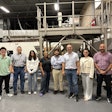
Nutrigenomics is the study of the effect of dietary bioactive compounds on gene expression. (Bioactives are molecules that can have a biological effect, independent of and in addition to any nutritional benefit they provide.) The ultimate goal of nutrigenomics is to be able to prevent, and even treat, disease through targeted nutrition. Not surprisingly, human nutrigenomics is more developed than dog and cat nutrigenomics. Hence, the following looks at the state of human nutrigenomics as a way to shed light on future petfood product development.
DNA is dynamic
We now know that DNA is not only responsible for the transfer of traits from parents to offspring, but that DNA plays a dynamic, active role in our daily lives. When we exercise, genes in our muscles are rapidly awakened to make proteins that help us to metabolize energy sources more effectively. When we are hungry, genes in our body are turned on that impact insulin levels. In addition, certain food substances have been identified that turn genes on or off.
Food substances, by interacting with DNA, can have a dramatic effect on susceptibility to diseases. For example, dietary fatty acids can regulate cellular function by modifying gene transcription. These gene modifications impact vasoconstriction, atherosclerosis and cancer.
Biomarkers, genetics testing
Nutrigenomics will find its way into our lives and our pets' lives through evolution, not revolution. Some scientists envision two key phases of products: the biomarker phase and the genetics phase. The biomarker phase is here now. It's based on the impact of bioactives on biomarkers (such as cholesterol or blood pressure) and endpoints (such as pain or mobility).
The genetics phase will be based on genetic testing. One day in the not-too-distant future, we will go to the doctor's office and have our DNA analyzed. The test results will be a personalized road map for disease prevention. If we know what diseases we are likely to contract, we can supplement our diets with personalized preventive products. Such DNA tests exist today, but only for a minuscule number of genes.
Lifestyles at odds with genes
The 21st century lifestyle is at odds with our genes and those of most our pets. Man evolved as a hunter-gatherer and most of our history was marked by periods of intense physical activity alternating with periods of famine, and a relatively short lifespan. But now we are sedentary, sated and tend to have a long lifespan. The consequences: the epidemic of diseases associated with inactivity and aging (obesity, cardiovascular disease, cancer, arthritis and diabetes). That's why scientists are on the hunt for bioactives that can reduce the effects of aging, reduce our tendency to store body fat and enhance the effects of exercise.
Real life applications
While consumers mainly focus on taste, convenience and price, the most important effects of food occur at the molecular level, generating significant effects on disease states, good or bad.
WellGen Inc. announced earlier this year that it has completed a pivotal study demonstrating that its nutrigenomics technology platform can accurately successfully predict biological activity of natural products (http://www.wellgen.com). WellGen now has a method of screening the effect of food on the expression of genes associated with human health conditions. The company has developed proprietary substances that help reduce risk and severity for a variety of different diseases.
Using an ingredient standardized for certain theaflavins in black tea, WellGen's study has shown that the ingredient's inflammation-fighting properties can be identified and quantified by the company's technology. These findings can be effectively translated into consumer applications. This is a big step for bringing nutrigenomics into mainstream product development in the food and beverage industry.
Highly predictive approach
WellGen completed a double-blind randomized human study that confirmed its approach of using cell cultures containing specifically targeted genes is highly predictive in determining that a plant extract can positively affect the same gene expression profile in humans.
WellGen's proprietary ingredient, WG0401, delivered consistent activity against inflammation across the entire development process. Inflammation plays an important role in many health states and is linked to such health concerns as arthritis, cardiovascular disease, cancer, and type II diabetes.
WG0401 provided protection to healthy volunteers who were given a potent inflammatory challenge. Healthy volunteers treated with the WellGen extract had inflammatory biomarker levels ranging between two- to six-fold less than the placebo group when challenged with an inflammation-inducing bacterial lipopolysaccharide.
As a proof of efficacy in humans, WellGen uses quantitation of biomarkers of inflammation to demonstrate the biological activity of its ingredients that have shown positive results in laboratory and animal tests. WellGen uses relevant and quantifiable biomarkers to streamline an ingredient's evaluation in humans by reducing the duration of human trials and obtaining objective data. Examples of validated biomarkers include glucose levels as related to diabetes or cholesterol levels related to heart health/cardiovascular risk.
Realizing the potential
Nutrigenomics discoveries continue to emerge and are being integrated into useful information on which the food and petfood industries can act. Clearly our industry's product development methods are changing. Alliances and partnerships among varied commercial and academic partners will be necessary to deliver on the scientific and commercial potential of nutrigenomics.

.png?auto=format%2Ccompress&fit=crop&h=167&q=70&w=250)














